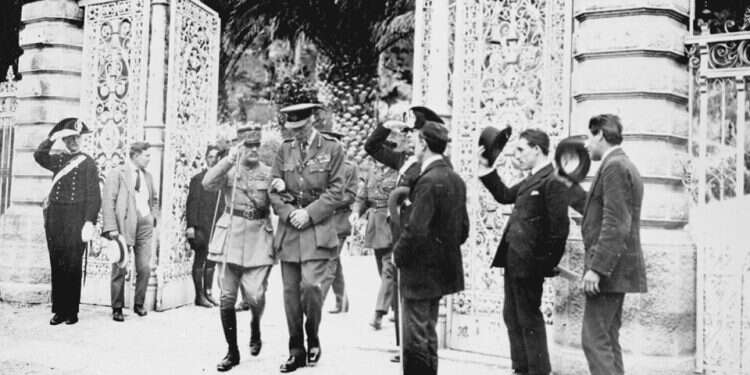This month, 101 years ago, the San Remo Conference, considered one of the founding events in the history of Zionism, closed in Italy, paving the way for the establishment of the State of Israel and essentially formed the geographical base of the modern Middle East of the 20th century.
Follow Israel Hayom on Facebook and Twitter
In the decision of the conference on the issue of the Land of Israel, the connection between the historical rights of the Jewish people to their land was recognized and they were granted legal rights over the entire Land of Israel. The decision was expressed by supporting the establishment of a Jewish home in the Land of Israel, based on the famous Balfour Declaration.
The inclusion of the Balfour Declaration in the conference summaries regarding the Land of Israel turned it from a non-binding British political declaration (expressing sympathy for the goal of Zionism to establish a Jewish state), into a binding document with international legal validity. The fulfillment of this goal was entrusted to Britain, which became the owner of the Mandate for the Land of Israel.
To understand the background to the San Remo Conference, it is important to go back to some of the events that preceded it. In 1916, during World War I, the Sykes-Picot Agreement was signed – a secret political agreement between Britain and France. The aim was to organize and divide the areas of control of the territories of the Ottoman Empire in the Middle East at the end of the war, which ended about two years later in the occupation of the region by the treaty countries, led by Britain and France.
In the summer of 1917, Chaim Weizmann (at the time one of the leaders of the Zionist movement) submitted a political proposal that he formulated with Nahum Sokolow. The proposal raised a request to recognize the right of the Jewish people to the Land of Israel and the right of Jews to immigrate to it and realize their national aspirations. On November 2, 1917, the historic document was signed by British Foreign Secretary Arthur James Balfour, known as the Balfour Declaration.
The document said: "I have much pleasure in conveying to you, on behalf of His Majesty's Government, the following declaration of sympathy with Jewish Zionist aspirations which has been submitted to, and approved by, the Cabinet. His Majesty's Government view with favour the establishment in Palestine of a national home for the Jewish people, and will use their best endeavors to facilitate the achievement of this object, it being clearly understood that nothing shall be done which may prejudice the civil and religious rights of existing non-Jewish communities in Palestine, or the rights and political status enjoyed by Jews in any other country."

In January 1919, about a month after the official end of World War I, the Paris Peace Conference opened, bringing together the allies who had won the war led by Britain, France and the United States, mainly to discuss peace agreements with the defeated.
During the conference's discussions regarding the future of the Land of Israel (in which they laid the foundation for the future British Mandate for Israel), a delegation of the "Committee of Jewish Delegations" headed by Weizmann also participated.
The delegation presented to the conference a map that included the territorial demands of the Jewish people, including territories from Lebanon, Syria, Jordan and the Sinai Peninsula. In addition, a memorandum was attached "to recognize the historical right of the Jewish people to the Land of Israel and the right of the Jews to re-establish their national home in the Land of Israel." It was also proposed in the document that sovereignty over the Land of Israel would be entrusted to the League of Nations, and the governing of the area would be handed over to Great Britain as a mandate.
A year later, in February 1920, a conference led by Britain, France and Italy was held in London. At the conference, disagreements arose between the British and the French regarding the Land of Israel. French Prime Minister Alexandre Millerand, who took office about a month earlier, was not sympathetic to the Zionist movement and tried to oppose the Balfour Declaration and the British government's intention to establish a national Jewish home in Israel.
Instead, he proposed reviving the Sykes-Picot agreement, under which Palestine would be under international rule. The British vehemently opposed it and British Prime Minister Lloyd George reinforced his position by reading to the French a telegram from US Supreme Court Justice Louis Brandeis, a Zionist leader in America and close friend of President Woodrow Wilson.
The letter came out against the implementation of the Sykes-Picot Agreement on the Land of Israel, which would in fact "defeat full realization of [the] promise of [a] Jewish [National] Home" with the only way to fulfill the Balfour Declaration which had been "subscribed to by France as well as other Allies and Associated Powers," was to concede the proposed Zionist boundaries.
'A general consensus'
On April 19, 1920, the leaders of the victorious powers met again for a week. The gathering place this time was Villa Devachan in the Italian city of San Remo, and the goal of the heads of these powers was to complete the work and ratify the resolutions of the London Conference.
The talks were attended by British Prime Minister Lloyd George, Foreign Secretary George Curzon, French Prime Minister Alexandre Millerand, French Foreign Secretary Philippe Berthelot, Italian Prime Minister Francesco Nitti, the Japanese representative, Japan's Ambassador to France Keishirō Matsui, and US Ambassador to Rome Robert Johnson, as well as representatives from Belgium and Greece.
At the end of that week, in the final two days of the conference, discussions focused on the issue of the future of the countries in the Middle East, and Palestine in particular. The delegates reaffirmed the terms of the Sykes-Picot agreement between France and Britain for the division of the region, and stipulated that the Land of Israel (Palestine) would be under British Mandate rule (which also included part of the Golan Heights and Trans Jordan), while Syria and Lebanon would be under French mandate, despite the opposition of the Arabs.
On the question of border locations between Israel, Syria and Lebanon, arguments arose between the British and the French. At the end of the discussions, the British managed to move the border as far north as possible, in order to ensure vital water resources and to include the Hula Valley, the Sea of Galilee and the Jordan River in the territories of the Land of Israel.
In addition, the establishment of a British mandate in the territory of the former Ottoman provinces – Baghdad, Mosul and Basra – to be called the British Mandate for Mesopotamia was also approved.
The next day, discussions focused on the future of Palestine and the question of the Balfour Declaration. On this issue (as happened earlier at the London Conference) the French expressed reservations about the declaration and its inclusion in the agreement, and as a result there was a harsh exchange between the two foreign secretaries of the countries.
Curzon demanded that the Balfour Declaration, adopted by the victorious powers earlier, be included in the Mandate for the Land of Israel "in the exact wording in which it was originally given." But Berthelot flatly rejected the idea, and although he acknowledged that the countries of the world did support the Jewish aspiration to establish a national home in the Land of Israel, including France itself, he suggested reconsidering it.
Berthelot argued that instead of including the Balfour Declaration in the Mandate, the issue of Israel should be discussed in the League of Nations, if only because "I do not remember that any general agreement was ever given to Mr. Balfour's declaration by the powers."
Curzon did not shy away from his remarks and replied, "Mr. Berthelot was possibly not fully acquainted with the history of the question," stressing that the terms of the Balfour Declaration were approved about two years ago by former Foreign Secretary Pichon, as well as US President Wilson and many other countries, including Italy, China and Greece, so he was "quite justified in saying that Mr. Balfour's declaration had been accepted by a large number of the Allied Powers."
During the debate between them, Italian Prime Minister Nitti intervened, saying: "It is useless to go into past history." He added that in his opinion "the Powers were generally in agreement as to the desirability of instituting a national home for the Jews."
Eventually, the French leadership withdrew its position regarding the Balfour Declaration and other issues, including the civil and political rights of the French community in the Land of Israel and the status of the holy places.
Beginning of the mandate period
In the closing statement approved at the end of the conference regarding the situation of Palestine and other countries in the region, and the status of the Balfour Declaration, the conference decided to include in the mandate the Balfour Declaration and impose on Britain, as the mandatory power, responsibility for implementing the declaration.
Among other things, it was agreed to "accept the terms of the mandates article with reference to Palestine on the understanding that there was inserted in the process-verbal an undertaking by the mandatory Power that this would not involve the surrender of the rights hitherto enjoyed by the non-Jewish communities in Palestine.
"The high contracting parties agree to entrust … the administration of Palestine ... to a mandatory, to be selected by the said Powers. The mandatory will be responsible for putting into effect the declaration originally made on the 8 November 1917, by the British Government and adopted by the other Allied Powers, in favor of the establishment in Palestine of a national home for the Jewish people, it being clearly understood that nothing shall be done which may prejudice the civil and religious rights of existing non-Jewish communities in Palestine; or the rights and political status enjoyed by Jews in any other country."
Subscribe to Israel Hayom's daily newsletter and never miss our top stories!
On July 1, 1920, following the decisions of the conference, Britain transferred to a civilian government in the Land of Israel headed by High Commissioner Herbert Samuel, inheriting the powers of the military government. About a month later, a peace treaty was signed between the Ottoman Empire and the treaty countries in Sevre, France, which officially included the decisions of the San Remo Conference.
Two years later, on July 24, 1922, the Council of the League of Nations approved the wording of the mandate, thus becoming a binding international document.
The importance of the San Remo Conference can be learned from the words of Chaim Weizmann, President of the Zionist Organization, and first president of the State of Israel. "The conference actually marked the birth of the State of Israel," he said. "The decision in San Remo, this recognition of our rights in Palestine which was included in the treaty with Turkey [the Sevre Treaty] and became part of international law – is the biggest political event in our movement [the Zionist movement]. And maybe, it would not be an exaggeration to say – in the entire history of the Jewish people since the diaspora."




